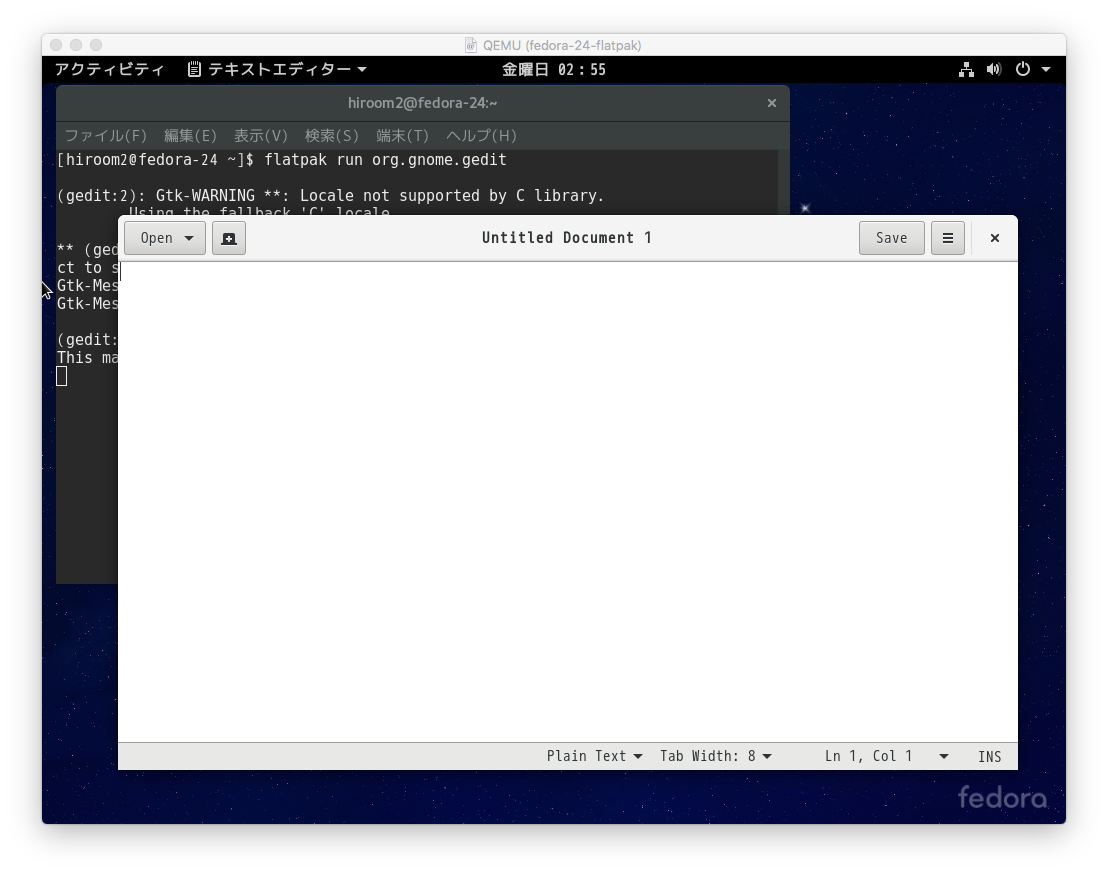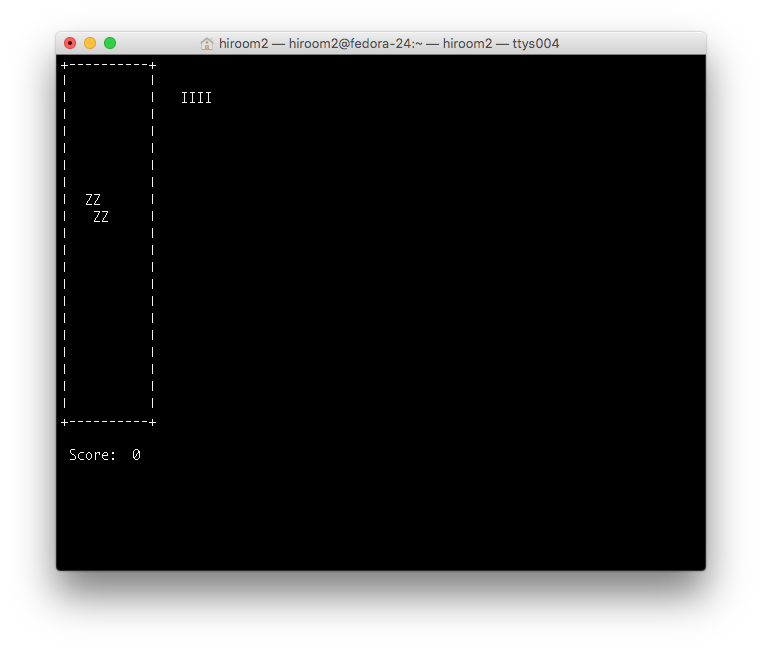This article will describe installing and building Flatpak.
Flatpak is renamed from xdg-apps.
Table of Contents
1 Flatpak
A Flatpak is framework for building application running on SandBox which has private root filesystem for application.
This will protect dependency of libraries for each application. The application built on x86 will be run on all x86 Linux. distribution.
Flatpak has application and runtime. The runtime has commands and libraries refered by application.
The runtime can be shared with multiple applications. This respects Linux dynamic library.
2 Install flatpak package
flatpak package is a tools for installing and building Flatpak. Install flatpak and flatpak-libs with dnf.
$ sudo dnf install -y flatpak flatpak-libs
3 Install application and runtime
Install application and runtime for user.
Import GPG key of GNOME repository.
$ wget https://sdk.gnome.org/keys/gnome-sdk.gpg $ flatpak --user remote-add --gpg-import=gnome-sdk.gpg gnome \ https://sdk.gnome.org/repo/
Import remote repository.
$ flatpak --user remote-add --gpg-import=gnome-sdk.gpg gnome-apps \ https://sdk.gnome.org/repo-apps/
Install org.gnome.Platform which is runtime. Unfortunately, installing org.gnome.Platform and org.gnome.Sdk is unstabled on 2016/7/3 and it will cause segmentaion fault.
Segmentation fault (core dumped) flatpak --user install gnome org.gnome.Platform 3.20
This issue will be avoided by reinstall these runtime. Runtime will be installed to ${HOME}/.local/share/flatpak/runtime.
$ while : ; do
flatpak --user install gnome org.gnome.Platform 3.20 &
pid=$!
sleep 300
ps -p ${pid} | awk '{ print $1 }' | grep ${pid} > /dev/null || break
sudo kill -KILL ${pid}
done
Install org.gnome.gedit which is application. Application is installled to ${HOME}/.local/share/flatpak/app.
$ flatpak --user install gnome-apps org.gnome.gedit stable
Run org.gnome.gedit.
$ flatpak --user run org.gnome.gedit
gedit window is poped.

3.1 Install Flatpak to system for sharing with all user
Running flatpak command without –user option but with privilege will install application to /var/lib/flatpak/app and runtime to /var/lib/flatpak/runtime. All user can access to these application and runtime.
$ sudo flatpak remote-add --gpg-import=gnome-sdk.gpg gnome \
https://sdk.gnome.org/repo/
$ sudo flatpak remote-add --gpg-import=gnome-sdk.gpg gnome-apps \
https://sdk.gnome.org/repo-apps/
$ while : ; do
sudo flatpak install gnome org.gnome.Platform 3.20 &
pid=$!
sleep 300
ps -p ${pid} | awk '{ print $1 }' | grep ${pid} > /dev/null || break
sudo kill -KILL ${pid}
done
$ sudo flatpak install gnome-apps org.gnome.gedit stable
$ flatpak run org.gnome.gedit
3.2 List of Flatpak in repository
Run remote-ls command with remote repository name.
$ flatpak remote-ls gnome-apps org.gnome.Builder org.gnome.Builder.Debug org.gnome.Builder.Locale org.gnome.Calculator org.gnome.Calculator.Debug org.gnome.Calculator.Locale org.gnome.Calendar org.gnome.Calendar.Debug org.gnome.Calendar.Locale org.gnome.Characters org.gnome.Characters.Debug org.gnome.Characters.Locale org.gnome.Dictionary org.gnome.Dictionary.Debug org.gnome.Dictionary.Locale org.gnome.Epiphany org.gnome.Epiphany.Debug org.gnome.Epiphany.Locale org.gnome.Evince org.gnome.Evince.Debug org.gnome.Evince.Locale org.gnome.Maps org.gnome.Maps.Debug org.gnome.Maps.Locale org.gnome.Polari org.gnome.Polari.Debug org.gnome.Polari.Locale org.gnome.Rhythmbox3 org.gnome.Rhythmbox3.Debug org.gnome.Rhythmbox3.Locale org.gnome.Todo org.gnome.Todo.Debug org.gnome.Todo.Locale org.gnome.Weather org.gnome.Weather.Debug org.gnome.Weather.Locale org.gnome.bijiben org.gnome.bijiben.Debug org.gnome.bijiben.Locale org.gnome.clocks org.gnome.clocks.Debug org.gnome.clocks.Locale org.gnome.eog org.gnome.eog.Debug org.gnome.eog.Locale org.gnome.gedit org.gnome.gedit.Debug org.gnome.gedit.Locale org.gnome.iagno org.gnome.iagno.Debug org.gnome.iagno.Locale
3.3 List of installed Flatpak
Run list command.
$ flatpak list org.gnome.gedit
4 Build application
Please build application with flatpak build. Building application withou flatpak build is for tutorial and building application with flatpak build is compatible with original building way (You only need to wrap command with flatpak build).
4.1 Building application without flatpak build (Not recommended)
Create simple application which run /bin/sh on SandBox.
Create directory.
$ mkdir shell $ mkdir shell/files $ mkdir shell/files/bin $ mkdir shell/export
Application provides command which named shell.sh.
- Running /bin/sh with arguments.
- Running /bin/sh when no arguments.
$ cat <<EOF > shell/files/bin/shell.sh #!/bin/sh if [ \$# -eq 0 ]; then PS1="shell> " /bin/sh else echo "shell> \$@" eval "\$@" fi EOF $ chmod a+x shell/files/bin/shell.sh
Create metadata which includes configuration of application.
- Application name is com.example.shell. Application name is ${name} in this article.
- Using org.gnome.Platform as runtime.
- Running com.example.shell will call shell.sh.
- Application access to "hosts" filesystem.
$ cat <<EOF > shell/metadata [Application] name=com.example.shell runtime=org.gnome.Platform/x86_64/3.20 command=shell.sh [Context] filesystems=host; EOF
Export shell directory to repo directory.
$ flatpak build-export repo shell $ ls repo/ config objects refs state summary tmp uncompressed-objects-cache
Register repo directory as example-repo. Install com.example.shell from example-repo.
$ flatpak --user remote-add --no-gpg-verify example-repo repo $ flatpak --user install example-repo com.example.shell
4.2 Building application with flatpak build (Recommended)
flatpak build command can build application on SandBox. This is not cross compile but own compile.
Install org.gnome.Sdk for building application.
$ while : ; do
flatpak --user install gnome org.gnome.Sdk 3.20 &
pid=$!
sleep 300
ps -p ${pid} | awk '{ print $1 }' | grep ${pid} > /dev/null || break
sudo kill -KILL ${pid}
done
This article will simple make source tree, but flatpak supports various build system like configure and cmake.
In case of normal binary is as below.
$ sudo dnf install -y ncurses-devel SDL2-devel SDL2_image-devel $ git clone https://github.com/hiroom2/tetris-sdl-and-ncurses $ cd tetris-sdl-and-ncurses $ make $ ./jni/src/ncurses # or ./jni/src/sdl
Build Flatpak as below.
- flatpak build-init starts flatpak build.
- Wrapping command with flatpak build is running on SandBox.
- flatpak build-finish finishes flatpak build.
$ flatpak build-init tetris com.hiroom2.tetris org.gnome.Sdk \ org.gnome.Platform 3.20 $ git clone https://github.com/hiroom2/tetris-sdl-and-ncurses $ cd tetris-sdl-and-ncurses/ $ flatpak build ../tetris make all install DESTDIR=/app $ cd .. $ flatpak build-finish tetris --command=ncurses
flatpak build uses org.gnome.Sdk and flatpak run uses org.gnome.Platform.
metadata is as below. You can change metadata manually.
$ cat tetris/metadata [Application] name=com.hiroom2.tetris runtime=org.gnome.Platform/x86_64/3.20 sdk=org.gnome.Sdk/x86_64/3.20 command=ncurses
Register repository and install application.
$ flatpak build-export repo tetris $ flatpak --user remote-add --no-gpg-verify tetris-repo repo $ flatpak --user install tetris-repo com.hiroom2.tetris
Run application.
$ flatpak run com.hiroom2.tetris
tetris is running.

4.3 Update application
Change source tree and export source tree to repo.
$ # update shell or tetris-sdl-and-ncurses directory $ flatpak build-export repo shell # or tetris-sdl-and-ncurses
flatpak udpate receives application update. flatpak update without application will receives all application update.
$ flatpak --user update com.example.shell # or com.hiroom2.tetris
4.4 Runtime
GNOME runtime and KDE runtime are there. It is nice to create daemon runtime for server and minimum runtime for embedded system.
GNOME runtime size is as below. This runtime can be shared with multiple application.
$ du -sh .local/share/flatpak/runtime/org.gnome.Platform 613M .local/share/flatpak/runtime/org.gnome.Platform $ du -sh .local/share/flatpak/runtime/org.freedesktop.Platform/ 391M .local/share/flatpak/runtime/org.freedesktop.Platform/
5 Structure of Flatpak
This article will describe structure of Flatpak according to this.
5.1 /app
Application is in ${HOME}/.local/share/flatpak/app/${name}/. When running application, files directory in this directory will be mounted to /app on SandBox. And /app is append to PATH and LD_LIBRARY_PATH on SandBox.
shell> echo $PATH /app/bin:/usr/bin shell> echo $LD_LIBRARY_PATH /app/lib:/usr/lib/GL
5.2 /usr
Runtime is in ${HOME}/.local/share/flatpak/runtim/${name}/. When running application, files directory in this directory will be mounted to /usr on SandBox.
$ ls .local/share/flatpak/runtime/org.gnome.Platform/x86_64/3.20/active/files/ bin etc include lib64 local sbin src cache games lib libexec manifest.json share var $ flatpak run com.example.shell ls /usr shell> ls /usr bin etc include lib64 local sbin src cache games lib libexec manifest.json share var
/bin is linked to /usr/bin, /lib is linked to /usr/lib, and /lib64 is linked to /usr/lib64.
$ flatpak run com.example.shell ls -l / shell> ls -l / total 44 drwxrwxr-x 3 hiroom2 hiroom2 4096 Jul 2 06:22 app lrwxrwxrwx 1 hiroom2 hiroom2 7 Jul 2 06:27 bin -> usr/bin drwxr-xr-x 4 hiroom2 hiroom2 300 Jul 2 06:27 dev drwxr-xr-x 20 hiroom2 hiroom2 1000 Jul 2 06:27 etc drwxr-xr-x 3 nfsnobody nfsnobody 4096 Jun 22 04:59 home lrwxrwxrwx 1 hiroom2 hiroom2 7 Jul 2 06:27 lib -> usr/lib lrwxrwxrwx 1 hiroom2 hiroom2 9 Jul 2 06:27 lib64 -> usr/lib64 drwx------ 2 nfsnobody nfsnobody 16384 Jun 15 01:25 lost+found drwxr-xr-x 2 nfsnobody nfsnobody 4096 Feb 4 07:10 media drwxr-xr-x 2 nfsnobody nfsnobody 4096 Feb 4 07:10 mnt drwxr-xr-x 2 nfsnobody nfsnobody 4096 Feb 4 07:10 opt dr-xr-xr-x 147 nfsnobody nfsnobody 0 Jul 2 06:27 proc drwxr-xr-x 4 hiroom2 hiroom2 120 Jul 2 06:27 run lrwxrwxrwx 1 hiroom2 hiroom2 8 Jul 2 06:27 sbin -> usr/sbin drwxr-xr-x 2 nfsnobody nfsnobody 4096 Feb 4 07:10 srv drwxr-xr-x 7 hiroom2 hiroom2 140 Jul 2 06:27 sys drwxr-xr-x 3 hiroom2 hiroom2 60 Jul 2 06:27 tmp drwxrwxr-x 13 hiroom2 hiroom2 4096 Jul 2 06:11 usr drwxr-xr-x 5 hiroom2 hiroom2 140 Jul 2 06:27 var
5.3 /etc
/etc files on SandBox are mounted from /etc files on host machine.
shell> cat /proc/mounts | grep /etc/ /etc/passwd tmpfs rw,seclabel,nosuid,nodev,relatime,uid=1000,gid=1000 0 0 /etc/group tmpfs rw,seclabel,nosuid,nodev,relatime,uid=1000,gid=1000 0 0 /dev/mapper/fedora-root /etc/machine-id ext4 rw,seclabel,nosuid,nodev,relatime,data=ordered 0 0 /dev/mapper/fedora-root /etc/shells ext4 rw,seclabel,nosuid,nodev,relatime,data=ordered 0 0 /dev/mapper/fedora-root /etc/default ext4 rw,seclabel,nosuid,nodev,relatime,data=ordered 0 0 /dev/mapper/fedora-root /etc/issue ext4 rw,seclabel,nosuid,nodev,relatime,data=ordered 0 0 /dev/mapper/fedora-root /etc/timezone ext4 rw,seclabel,nosuid,nodev,relatime,data=ordered 0 0 /dev/mapper/fedora-root /etc/host.conf ext4 rw,seclabel,nosuid,nodev,relatime,data=ordered 0 0 /dev/mapper/fedora-root /etc/filesystems ext4 rw,seclabel,nosuid,nodev,relatime,data=ordered 0 0 /dev/mapper/fedora-root /etc/xdg ext4 rw,seclabel,nosuid,nodev,relatime,data=ordered 0 0 <snip>
/etc/passwd and /etc/group includes only user who run application and nfsnobody.
shell> cat /etc/passwd hiroom2:x:1000:1000:Unknown:/home/hiroom2:/bin/sh nfsnobody:x:65534:65534:Unmapped user:/:/sbin/nologin shell> cat /etc/group hiroom2:x:1000:hiroom2 nfsnobody:x:65534:
5.4 /dev
Basic device file is mounted.
shell> ls /dev console full null ptmx pts random shm stderr stdin stdout tty urandom zero
5.5 /proc
Running "ps a" on SandBox outputs as below.
shell> ps a
PID TTY STAT TIME COMMAND
1 ? S+ 0:00 /usr/libexec/flatpak-bwrap --args 13 shell.sh ps a
2 ? S+ 0:00 /bin/sh /app/bin/shell.sh ps a
3 ? R+ 0:00 ps a
This tells that flatpak-bwrap is running command.
flatpak-bwrap -> /bin/sh -> shell.sh
/proc on SandBox is as below. Only application's PID files are there. PID 1 is flatpak-bwrap, PID 2 is /bin/sh, PID 3 is shell.sh and PID 70 is ls command.
shell> ls /proc/ 1 cpuinfo iomem latency_stats partitions sysvipc 2 crypto ioports loadavg sched_debug thread-self 3 devices irq locks schedstat timer_list 70 diskstats kallsyms mdstat scsi timer_stats acpi dma kcore meminfo self tty asound driver key-users misc slabinfo uptime buddyinfo execdomains keys modules softirqs version bus fb kmsg mounts stat vmallocinfo cgroups filesystems kpagecgroup mtrr swaps vmstat cmdline fs kpagecount net sys zoneinfo consoles interrupts kpageflags pagetypeinfo sysrq-trigger
5.6 /sys
Basic /sys files is mounted.
$ ls /sys/ block bus class dev devices firmware fs hypervisor kernel module power $ flatpak run com.example.shell ls /sys shell> ls /sys/ block bus class dev devices
5.7 /var
/var has writable directories.
| Host machine | Shell |
|---|---|
| ${HOME}/.var/app/${name}/cache | /var/cache |
| ${HOME}/.var/app/${name}/config | /var/config |
| ${HOME}/.var/app/${name}/data | /var/data |
5.8 Context filesystems in metadata
Application can use writable directory with Context filesystems in metadata.
Context filesystems supports below directories.
| host | Host Mahine filesystem except dev, proc, /sys and /var |
| home | User homedirectory |
| xdg-xxx | XDG_XXX variable directory |
| Absolute path | opt/path/to or ~.local/path/to |
The mapping xdg variable and XDG variable are as below.
| xdg variable | XDG variable | Fedora 24 |
|---|---|---|
| xdg-desktop | XDG_DESKTOP_DIR | ${HOME}/Desktop |
| xdg-documents | XDG_DOCUMENTS_DIR | ${HOME}/Documents |
| xdg-download | XDG_DOWNLOAD_DIR | ${HOME}/Downloads |
| xdg-music | XDG_MUSIC_DIR | ${HOME}/Music |
| xdg-pictures | XDG_PICTURES_DIR | ${HOME}/Pictures |
| xdg-public-share | XDG_PUBLICSHARE_DIR | ${HOME}/Public |
| xdg-templates | XDG_TEMPLATES_DIR | ${HOME}/Templates |
| xdg-videos | XDG_VIDEOS_DIR | ${HOME}/Videos |
| xdg-run | XDG_RUNTIME_DIR | /var/user/<pid> |
You can use multiple directory with ; like org.gnome.gedit.
filesystems=xdg-run/dconf;host;~/.config/dconf:ro;